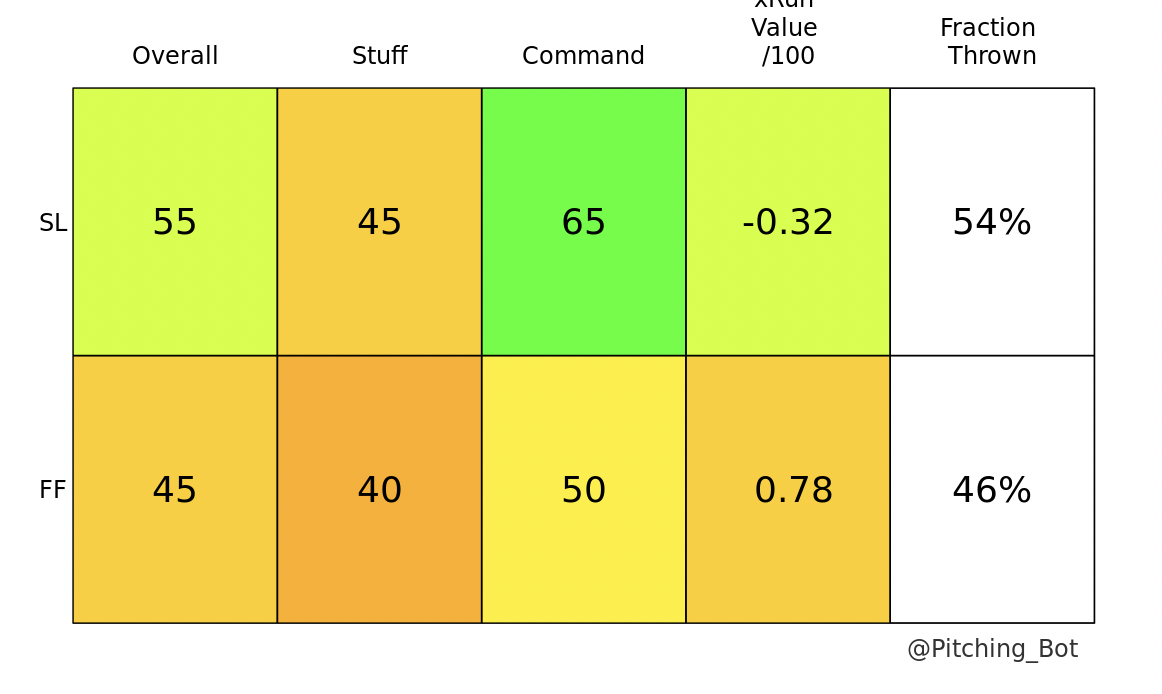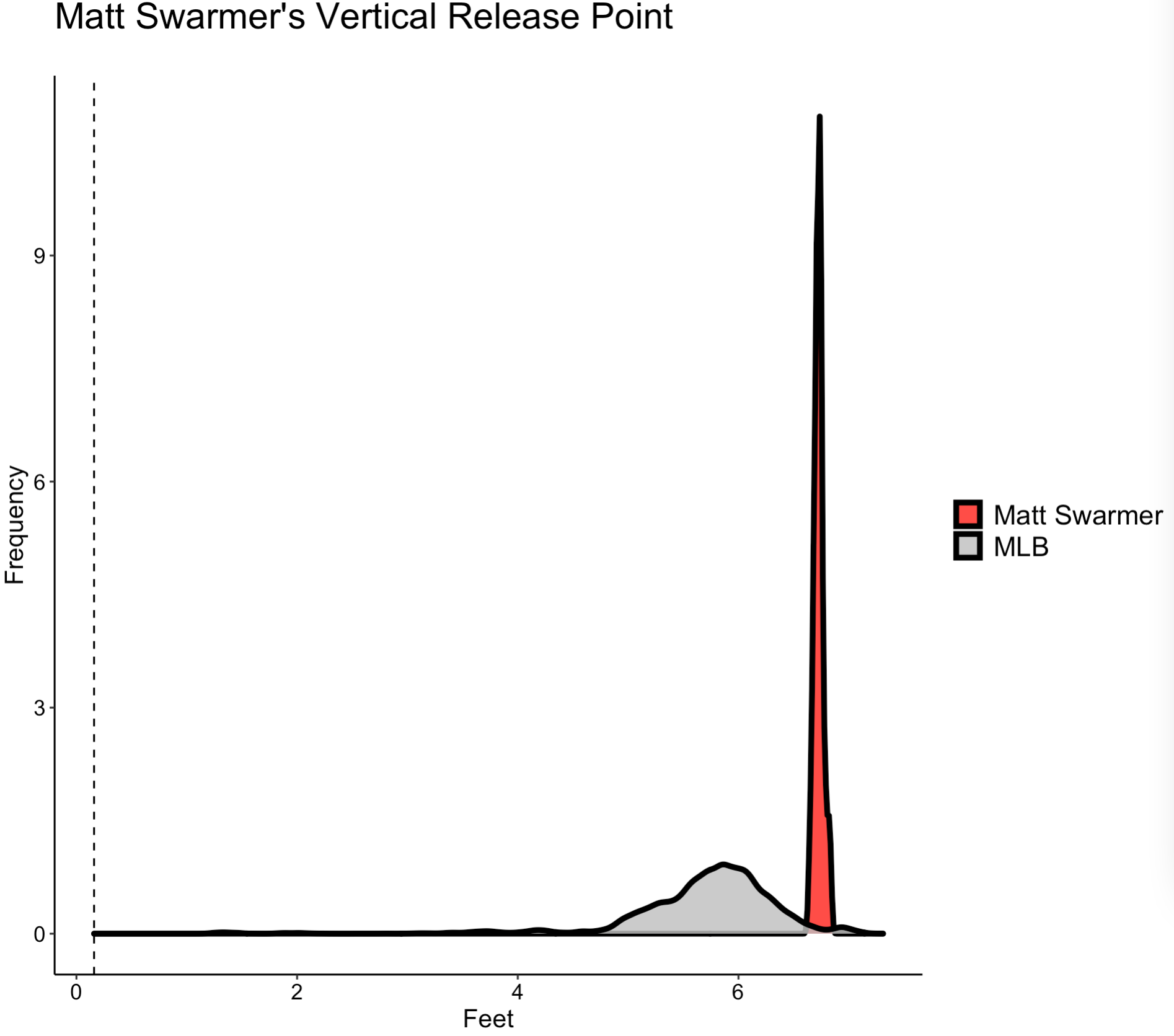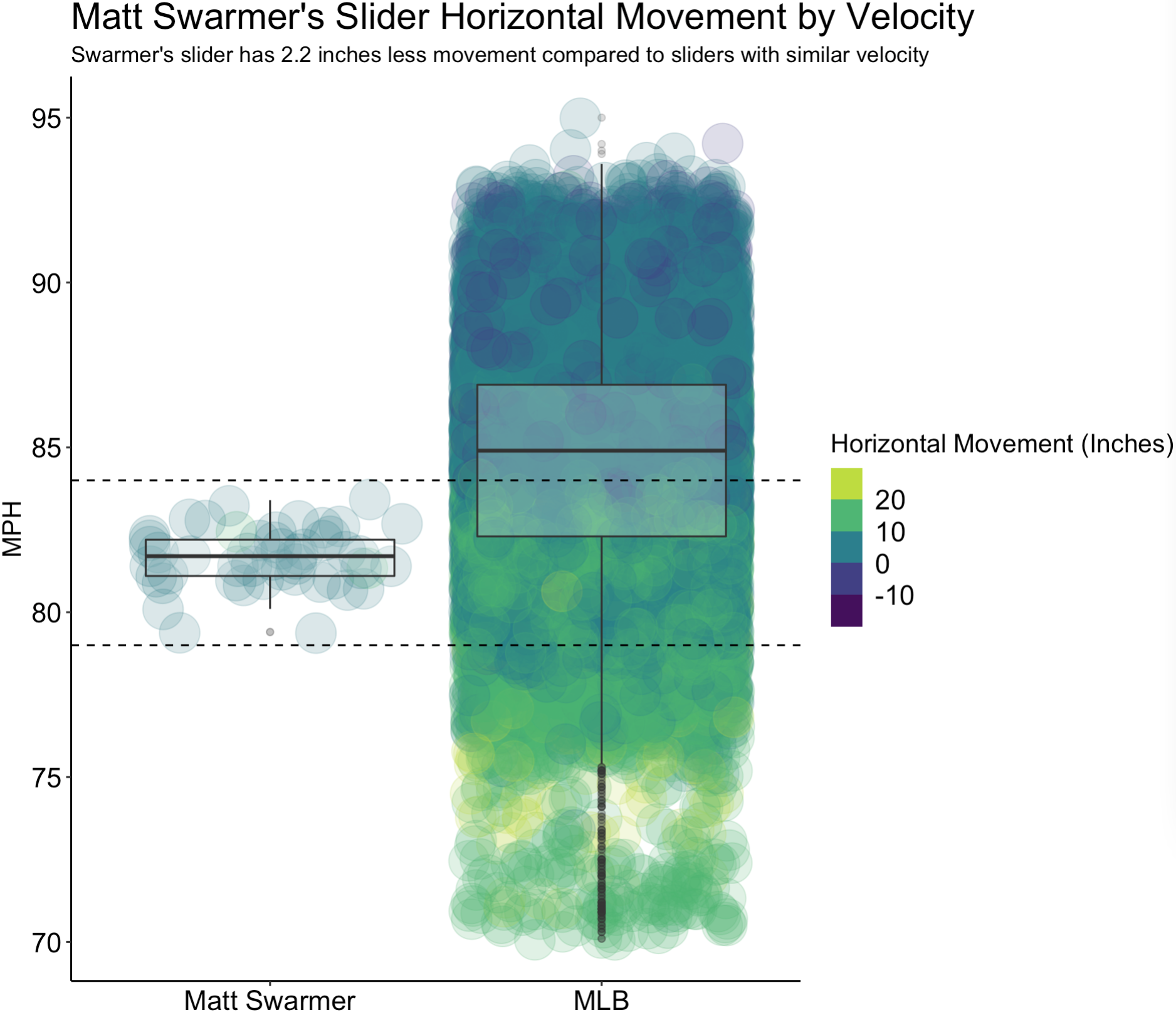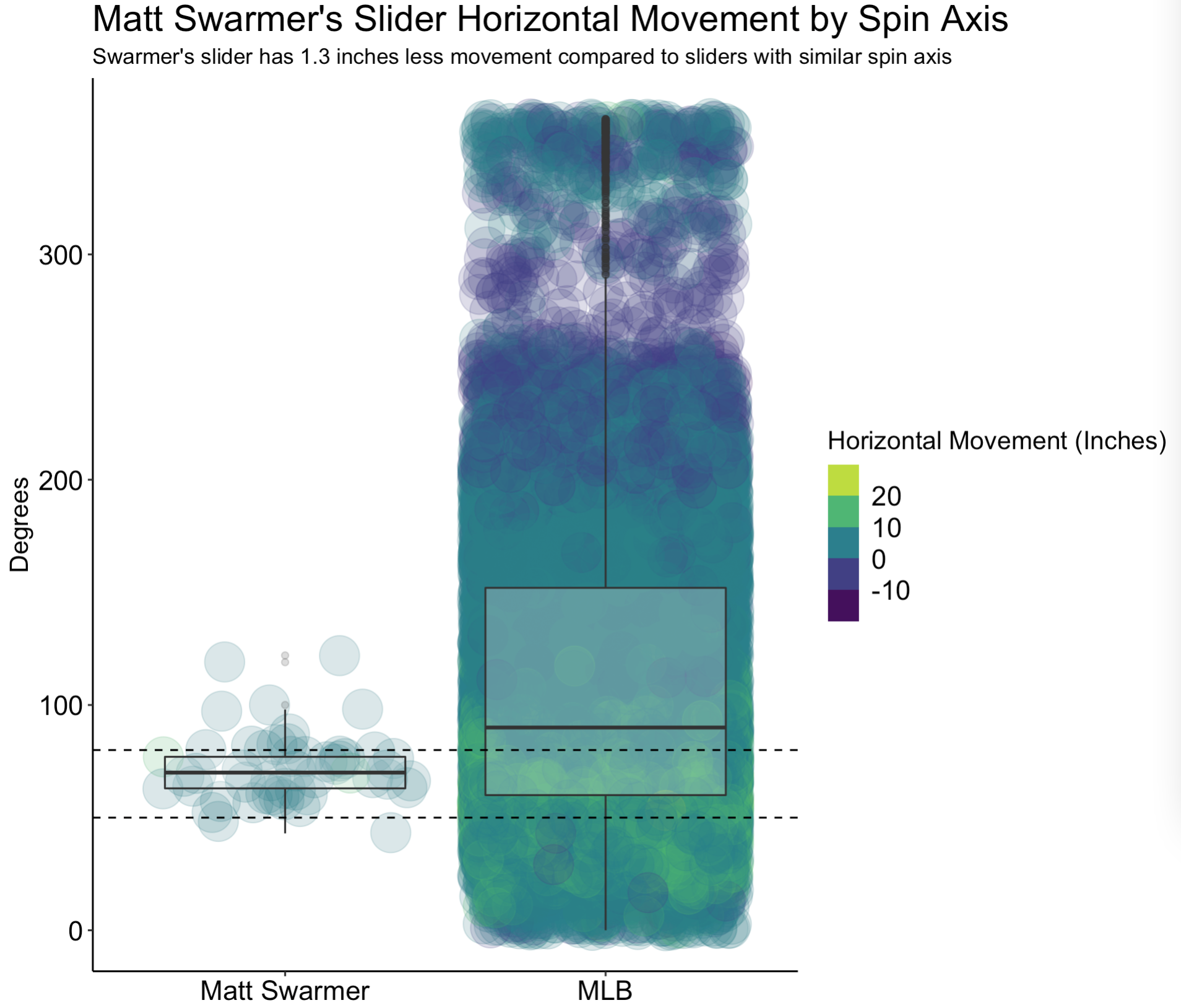© 2024 ALLCITY Network Inc.
All rights reserved.

At 28 years old, Matt Swarmer is now receiving significant attention following six years in the Cubs’ farm system. In just two MLB starts, the rookie has struck out 11 batters while only allowing two runs in 12 innings.
After Swarmer earned his first career win over the Cardinals on Saturday, two questions percolated throughout Cubs fanbase:
Why has Swarmer suddenly been so successful? Can his success continue?
We talked with Swarmer about the reasons for his success, and then we followed up by analyzing his Statcast data.
Swarmer throws his slider more than any other pitch
Whereas most starting pitchers lead with the fastball, Swarmer leads with his slider — over 50% of Swarmer’s total pitches have been a slider. His “slider-first” mentality is a recent development, prompted by the Cubs pitching infrastructure.
Swarmer explained to CHGO Cubs beat writer Ryan Herrera that he recently started to lead with sliders.
“It was mainly this year.” Swarmer said. “(Triple-A Iowa coaches) said, ‘Use your slider.’ Actually, I was supposed to use it more than my fastball because it helps me get hitters out easier. My fastball, they just say, ‘Just hit your spots, corners, black to white.’ I just try to go with my fastball and try to throw it in the same location as [my slider], because it kind of messes with hitters’ timing and stuff.”
Surprisingly, Statcast data suggests Swarmer’s slider is below average
Despite throwing so many sliders, the pitch grades below league average. In statistical models that attempt to explain pitch value, velocity and movement separation from fastballs are among the most important predictors. Swarmer’s slider’s vertical movement and velocity separation from fastball is exactly league average. Consequently, his stuff’s grade is underwhelming.
Indeed, according to baseball statistician Cameron Groove’s models, the pitch grades 45/80 on stuff alone (data from first two starts; figure shown below).

Swarmer’s slider vertical release point is taller than 99% of MLB pitchers
Although Swarmer’s slider grades poorly by grade algorithms, its success might be an outlier due to extreme mechanics.
Swarmer said his slider has been successful because of its unique release point and shape. He emphasized that his slider actually behaves more like a splitter than a breaking pitch.
“It’s grip, but also, I throw from over the top,” Swarmer explained. “If anything, it’s just going to come straight down, so it kind of looks like a splitter. I was looking at some of the video, too, and I’m like, ‘Man, that comes down. It doesn’t even look like a slider.’ But I call it a slider because I grip it like a slider, but it’s just the way I throw. If I threw from the side, it’d probably look more like a slurve. I just stay over the top. It feels good coming out. I just want to keep everything looking like a fastball.”
Swarmer’s slider vertical release point is among the highest in MLB. At the point of his release, his slider stands high at 6-foot-7, taller than 99% of all sliders thrown in MLB this season, as shown below.

Take a look for yourself at his extremely tall release point (and enjoy the whiff).

Swarmer’s slider release point is similar to his fastball release point
Furthermore, the data mirrors Swarmer’s thought that his slider release point is similar to his fastball. Compared to other pitchers, Swarmer’s slider vertical release point is more similar to his fastball vertical release point.

The vertical break is unique when considering spin axis and velocity
“I kind of developed it with my pitching coach in Triple-A, (Ron Villone),” Swarmer said. “We kind of reestablished it, because it was more of like a slurve. He always tells me, ‘Grip it and rip it. Don’t slow your arm down.”
This “grip it and rip it” mentality has contributed to a linear shape. Compared to sliders with similar velocity, Swarmer’s pitch moves with 2.2 inches less horizontal movement. This is illustrated by the below figure, in which the colored dots represent one pitch by horizontal movement with the y axis as velocity in mph. Notice how Swarmer’s dots (i.e., individual sliders) are darker green (i.e., less movement) relative to MLB slider’s with similar velocity (lighter green). This difference is considered extremely statistically significant when modeled using regression techniques.

Likewise, compared to sliders with similar spin axis (i.e., the angle at which sliders spin), his pitch moves with 1.3 inches less horizontal movement. This difference is also considered statistically significant during statistical regression.

Due to this lower-than-expected horizontal movement, Swarmer’s slider appears more linear.
Cubs manager David Ross expanded on Swarmer’s slider linearity on Saturday: “The lefties read fastball out of hand. It’s on the same plane as the fastball, and then it just kind of disappears. You get real fastball swings from hitters. Not like, oh there’s a slider and I try to adjust my swing. They swing through it. That means it looks just like a fastball out of hand and just goes straight down.”
You can really get a feel for Swarmer’s “disappearing” slider by the yellow pitch tracker in the video below.

Will Swarmer’s success continue?
Swarmer showcased both a fascinating, unique release point and shape in his first two starts, but not mentioned thus far has been exceptional command, as shown below in the heat map. His command was so sharp that pitch graders have rated it 65/80 (first figure above).

Swarmer’s elite command combined with 99th percentile release point and unique shape does suggest he could be a legit starting pitching option.
But pitchers with just two pitch types have difficulty getting through the batting order multiple times. Swarmer has thrown either a slider or four-seam fastball in over 97% of total pitches. This is one of his significant limitations. However, if starting does not ultimately work, he could be a legitimate multi-inning threat.
Nevertheless, Ross compared Swarmer to pitcher he caught back in his playing days, who started 381 games with a 4.26 ERA.
“I caught a guy back in Cincinnati, had a really nice career, Aaron Harang, was just fastball/slider,” Ross said.”The slider wasn’t even a plus pitch. It was just that the fastball was so deceptive that he had to commit to that and it played up. And then the slider, I think that’s the reverse effect of Matty. The slider is so effective. You have to slow down, and the fastball plays up.”
Final thoughts
Whether Swarmer ultimately becomes a starter or multi-inning reliever is to be determined, but the relationship between the Cubs’ pitching infrastructure and Swarmer has made both options a legitimate possibility, and that alone is impressive.
As I’m writing this, I can’t help but be enthusiastic about the Cubs’ pitching infrastructure. They are bringing out the most potential from a starting pitcher who doesn’t have high-level stuff. That, along with a receptive and hard-working pitcher in Swarmer, has made the absolute most out of a slider.
Get Our Best Cubs Content In Your Inbox!Become a smarter Chicago Cubs fan with Ryan Herrera's Cubs Newsletter!
Just drop your email below!
Comments
Share your thoughts
Join the conversation


